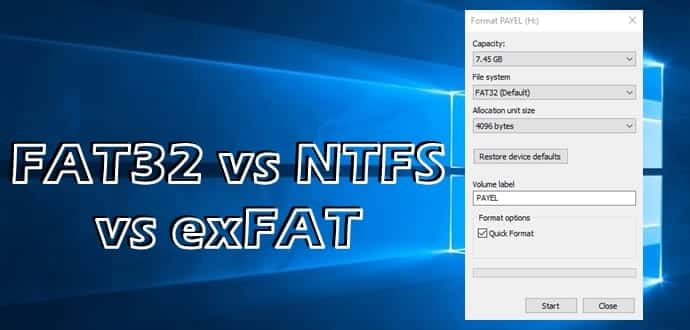FAT32 vs NTFS vs exFAT which one to use
If you’ve ever seen the properties or formatted a hard drive, you would have come across a screen that asks your preference of file system. Though you must’ve selected the recommended option, you must’ve wondered what the file systems mean and what are the differences between them.
Back Story
A file system stands for the methods and data structures that the OS uses to keep track of files on a disk or partition, or in other words, it defines the way the files are managed in the system. The word is also used when referring to a partition or disk that is used to store files. More often than not, an OS will have in-built support for multiple file systems. At times, the OS and the file system are too tightly bound together to even differentiate the file system function from the rest. Now, we are going to discuss about the details of the popular file systems.
NTFS
NTFS is the modern file system of choice. Preferred by Windows since it introduces it back in 1993 with Windows NT , the OS will format your system drive and set it to NTFS by default. NTFS has file size and partition size limits that are so theoretically huge you won’t run up against them. It is also recommended to have any drive that you plan to run software on, to be the NTFS format.
NTFS comes packed with the modern features we’re most used to. It supports file permissions for security, a change journal that can help quickly recover errors if your computer crashes, shadow copies for backups, encryption, disk quota limits, hard links, and other various features.
NTFS works with every recent edition of Windows as you’d have guessed. Mac OS however, is set to only read files from an NTFS system by default. Linux distributions are divided on NTFS support with some supporting it and others not.
FAT32
FAT is considered to be the granddaddy of file systems. This particular format was introduced in Windows 95 as a replacement to FAT16. The file system, being as old as it is, has now become the de-facto standard. USB drives usually come formatted with this system to allow maximum compatibility across devices. The family of FAT is supported almost universally.
However, since the system has been in use for so long, it also comes with a certain limitations. While they might not been a problem when the system was first introduced, after all these years, the drawbacks seem serious. Individual files have an upper limit of 4 GB on the FAT 32 system. A partition formatted with FAT32 has a limit of 8TB which might not be too big of a problem now, but it is noticed by more heavy duty users.
While the system is probably the best for external drives, it certainly isn’t recommended for internal hard drives. It lacks the permissions and other security features built into the more modern NTFS file system. Modern versions of Windows do not support FAT32 system for the system drive as we already discussed.
exFAT
This is a proprietary file system with certain definitive advantages over NTFS and was introduced in 2006. The system is supported by multiple editions of Windows including Windows Server 2003, Windows Vista, Windows 2008, Windows 7, Windows 8 and more.
Like NTFS, this format too supports a large file and disk partition size limits therefore, you can surpass the 4 GB limit of the previous system. Being an upgrade over FAT 32 system, this is an obvious option to enjoy the benefits of the exFAT file system without the limitations. It is also compatible with NTFS, works with every available version of Windows as well as Mac OS. On Linux, if you find it not working by default, there are software available to enable compatibility.

